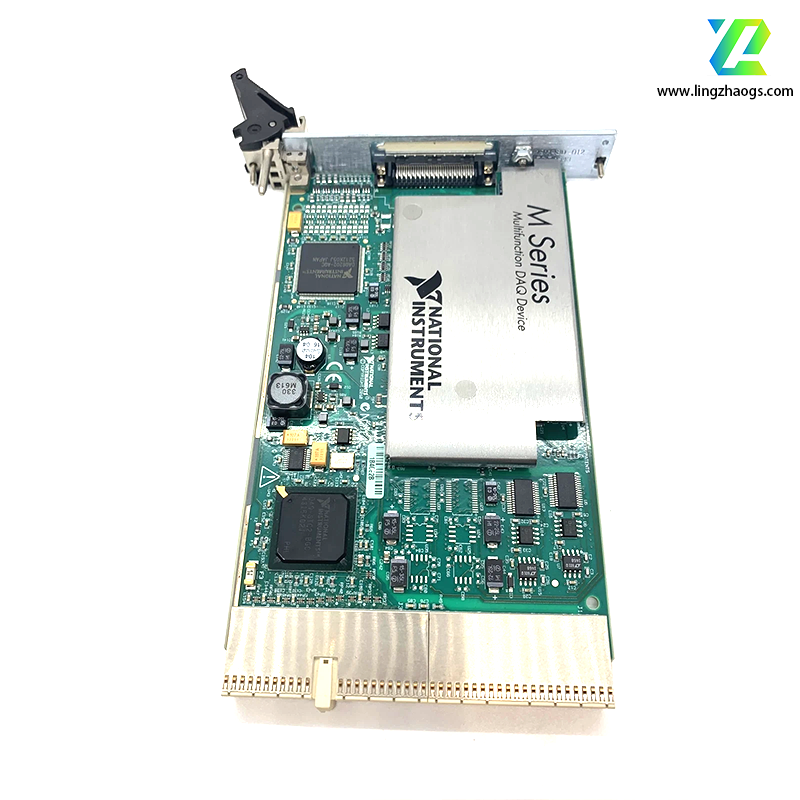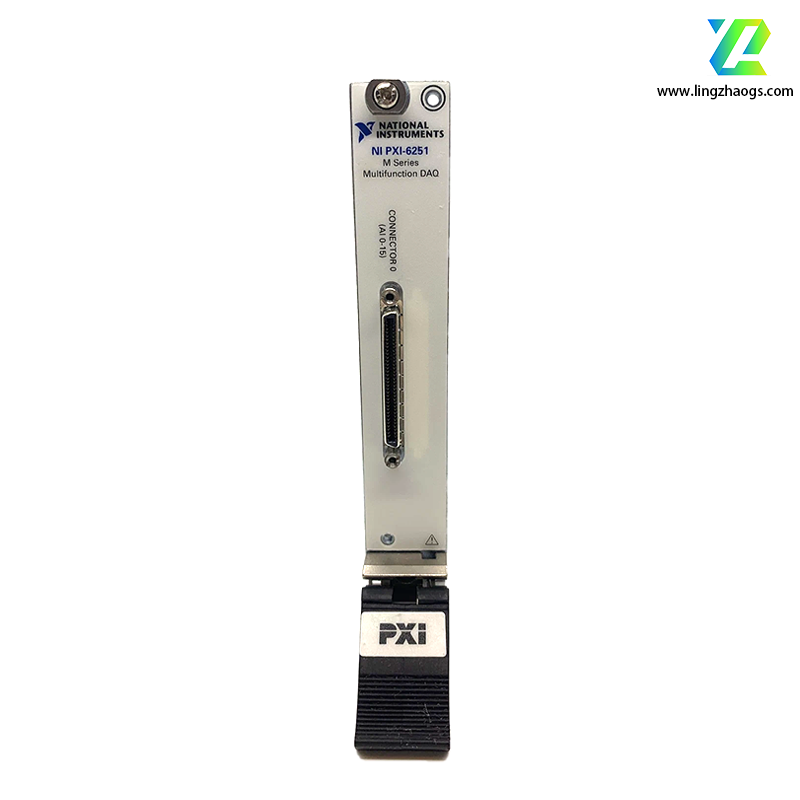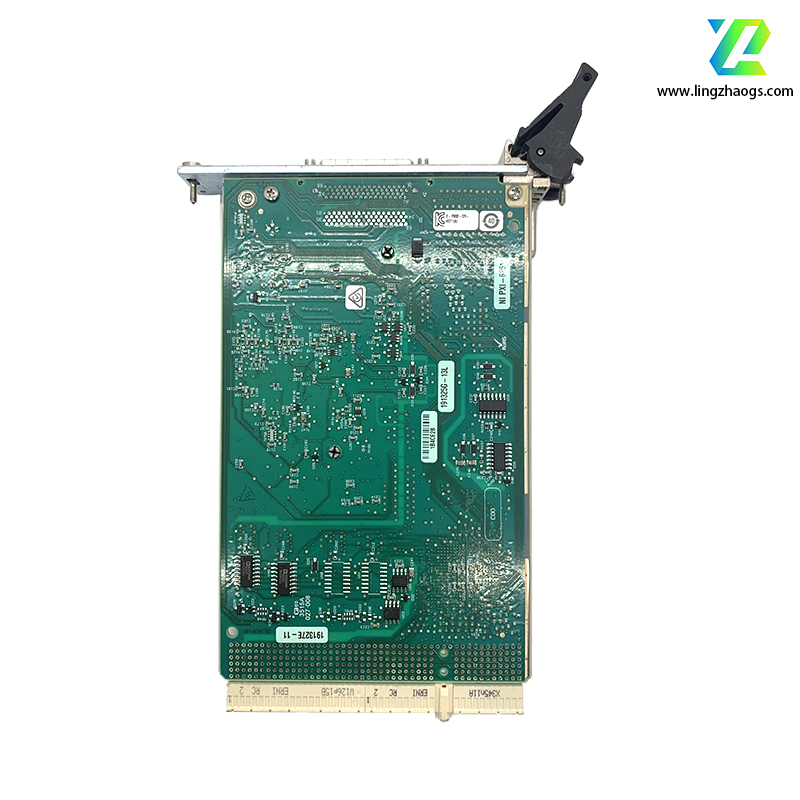Detailed Specifications of NI PXI-6251 Multifunction DAQ Module
The NI PXI-6251 is a high-performance multifunction data acquisition (DAQ) module from National Instruments’ (NI) M-Series, specifically designed for the PXI bus architecture. It combines high-speed analog input, flexible analog output, programmable digital I/O, and precision counter/timer functions, making it a versatile solution for high-throughput measurement tasks in industrial testing, laboratory automation, and scientific research.
1. Basic Information
- Module Series: M-Series multifunction DAQ, optimized for PXI bus systems to ensure stable data transmission and synchronization.
- Part Numbers: 779071-01 (standard variant), with regional compliance versions available (e.g., for CE, FCC).
- Physical Dimensions: 3.8 × 6.1 inches (9.65 × 15.49 cm), compatible with standard 3U PXI chassis (3U form factor).
- Weight: Approximately 5 ounces (0.14 kg), lightweight for easy integration into compact systems.
- Power Requirements: +5 V (0.75 A), +3.3 V (0.04 A), +12 V (0.38 A); low power consumption to reduce system heat generation.
- Connector Type: 68-pin VHDCI (Very High-Density Cable Interconnect) I/O connector, enabling compact and reliable signal connections.
- Operating Temperature Range: 0°C to 55°C (commercial grade); -40°C to 85°C (extended temperature grade available as an option).
- Protection Ratings: IP30 ingress protection; ruggedized aluminum housing to resist shock (100 g peak) and vibration (5 g rms), suitable for industrial environments.
2. Core Technical Specifications
2.1 Analog Input
- Channel Configuration: 16 single-ended channels or 8 differential channels; supports referenced single-ended (RSE), non-referenced single-ended (NRSE), and differential (DIFF) input modes to adapt to different sensor signal types.
- Resolution: 16-bit ADC (Analog-to-Digital Converter) with no missing codes (guaranteed differential nonlinearity, DNL: ±0.5 LSB), ensuring high measurement precision.
- Sampling Rate: Up to 1.25 MS/s (single-channel, maximum throughput); 1.0 MS/s aggregate throughput in multi-channel multiplexing mode, enabling high-speed simultaneous signal acquisition.
- Input Range: Switchable across 7 ranges to match diverse signal amplitudes: ±0.1 V, ±0.2 V, ±0.5 V, ±1 V, ±2 V, ±5 V, ±10 V.
- Overvoltage Protection: ±25 V (when powered on) and ±15 V (when powered off) for analog input pins; maximum input current of ±20 mA per pin during overvoltage events, preventing module damage.
- Input Impedance: >10 GΩ (parallel with 100 pF) when powered on; 820 Ω when powered off, minimizing loading effects on measured signals.
- Common-Mode Rejection Ratio (CMRR): 100 dB (DC to 60 Hz), effectively suppressing common-mode noise in industrial environments.
- Small Signal Bandwidth (-3 dB): 1.7 MHz, supporting acquisition of high-frequency analog signals.
- Settling Time: 1 μs (±60 ppm of step) for ±1 V to ±10 V ranges; 8 μs (±15 ppm of step) for ±0.1 V/±0.2 V ranges, ensuring fast signal stabilization after range switching.
- Memory Buffer: 4,095-sample input FIFO (First-In-First-Out) and 4,095-entry scan list memory, reducing CPU load during high-volume data acquisition.
2.2 Analog Output
- Channel Count: 2 independent analog output channels, supporting simultaneous waveform generation and static voltage output.
- Resolution: 16-bit DAC (Digital-to-Analog Converter); integral nonlinearity (INL): ±1 LSB, differential nonlinearity (DNL): ±0.5 LSB, ensuring accurate voltage output.
- Update Rate: 2.86 MS/s per channel, enabling high-speed waveform generation (e.g., sine waves, square waves, arbitrary waveforms) for control or stimulus applications.
- Output Range: ±10 V (standard); output current up to ±5 mA per channel, compatible with most industrial actuators, drivers, and test equipment.
- Output Impedance: 0.1 Ω (typical), minimizing signal distortion during output.
- Protection: Short-circuit protection (current-limited to ±20 mA), preventing damage from accidental short circuits to ground.
2.3 Digital I/O
- I/O Lines: 24 programmable digital I/O lines, compatible with 5 V TTL/CMOS logic levels.
- Configuration: Each line can be independently set as input or output; supports both push-pull and open-drain output modes (configurable via software).
- Functionality: Enables digital triggering, correlated I/O (synchronized with analog I/O), and pattern generation. Suitable for controlling external devices (e.g., relays, solenoids, LEDs) and monitoring status signals (e.g., limit switches, sensor outputs).
- Input/Output Current: 24 mA sink/source per line, providing sufficient driving capability for industrial-grade components.
- Timing: Synchronized with a 20 MHz internal clock, supporting digital signal sampling and generation at up to 10 MHz.
2.4 Counter/Timer
- Configuration: 2 independent 32-bit counters/timers with an 80 MHz base clock, ensuring ultra-precise timing.
- Clock Sources: Supports internal (0.1 MHz, 20 MHz, 80 MHz) and external (0–20 MHz) clock inputs, flexible for different timing requirements.
- Supported Tasks: Event counting, frequency measurement (up to 10 MHz), period measurement (minimum 100 ns), time-interval measurement (resolution 50 ns), pulse width modulation (PWM), and pulse generation.
- Trigger Integration: Can be synchronized with analog I/O and digital I/O via the PXI backplane, enabling coordinated multi-function operations (e.g., triggering analog acquisition via a counter event).
2.5 Synchronization & Triggering
- Synchronization Capability: Supports nanosecond-level clock synchronization through the PXI backplane (PXI_Trig lines and PXI_Star trigger). Enables phase-coherent acquisition across multiple NI DAQ modules (e.g., multiple PXI-6251 units or other M-Series modules) for large-scale measurement systems.
- Analog Trigger: Edge-triggered (rising or falling edge) with adjustable threshold (range: ±10 V), suitable for triggering acquisition based on analog signal levels.
- Digital Trigger: Edge-triggered (rising/falling edge) via digital I/O lines or PXI backplane triggers, compatible with TTL logic levels.
- Software Trigger: Triggered via API commands, flexible for automated test sequences.
- Signal Conditioning Compatibility: Seamlessly integrates with NI SCC (Signal Conditioning Cartridge) and SCXI modules (e.g., SCXI-1125 for amplification, SCXI-1144 for isolation) to extend measurement capabilities—supporting sensor signal amplification, filtering (2 Hz low-pass to 100 kHz high-pass), and galvanic isolation (2,500 Vrms) for noisy or high-voltage environments.
3. Software & Driver Support
- Drivers: NI-DAQmx 9.0 or later (recommended) and NI-DAQmx Base. These drivers provide intuitive APIs for device configuration, data acquisition, and result processing, simplifying development and reducing time-to-market.
- Programming Compatibility:
- NI Software Ecosystem: Fully compatible with LabVIEW (8.2.x+), LabWindows/CVI (8.1.x+), Measurement Studio (8.0.x+), and LabVIEW SignalExpress (2.5.x+). LabVIEW offers graphical programming for rapid prototyping, while LabWindows/CVI supports textual C-based development.
- Third-Party Languages: Supports C/C++, C#, MATLAB (via NI-DAQmx Toolbox), Python (via pyDAQmx bindings), and Visual Basic. Enables integration with existing software platforms (e.g., MATLAB for data analysis, Python for automation scripts).
- Calibration: Built-in NI-MCal (NI Modular Calibration) technology, which automatically compensates for nonlinearity, offset, and gain errors. Recommended calibration interval: 2 years to maintain measurement accuracy (±0.01% of full scale for analog input).
- Diagnostic Features: Real-time self-test functions (e.g., signal path verification, clock integrity checks) and error logging (via driver APIs). Facilitates quick troubleshooting and predictive maintenance for industrial systems.
4. Typical Application Scenarios
The NI PXI-6251 is ideal for high-speed, high-precision measurement tasks across industries, including:
- Industrial Automation & Process Control: High-speed monitoring of production line parameters (e.g., temperature, pressure, flow rate) in automotive, semiconductor, and chemical manufacturing. Supports real-time feedback control for process optimization (e.g., adjusting valve positions based on analog input signals).
- Aerospace & Defense: Avionics system testing (e.g., sensor signal acquisition for flight control systems), missile guidance component calibration, and radar signal processing (with high-bandwidth analog input support).
- Scientific Research: Material testing (e.g., stress-strain data acquisition for composite materials), biomedical signal analysis (e.g., EEG/ECG monitoring with signal conditioning), and physics experiments (e.g., low-noise measurement of particle detector signals).
- Electronics Test & Validation: High-speed testing of electronic components (e.g., ADC/DAC performance verification), circuit board functional testing, and consumer electronics quality control (e.g., smartphone sensor calibration).
- Energy & Utilities: Power grid transient signal acquisition (e.g., voltage/current spikes during fault events), renewable energy system monitoring (e.g., solar panel output tracking), and battery performance testing (e.g., charging/discharging cycle measurement).
5. Selection & Compatibility Notes
- Ideal Use Cases: Applications requiring high sampling rates (<1.25 MS/s), 16-bit precision, and dual analog outputs—especially when multi-module synchronization or high-channel-density measurement is needed.
- For higher sampling rates (up to 2 MS/s), consider the NI PXI-6281 (16-bit, 2 MS/s analog input).
- For isolated analog I/O (to prevent ground loops in industrial environments), opt for the NI PXI-6289 (16-bit, 1 MS/s, isolated channels).
- For more analog output channels (4 channels), choose the NI PXI-6259 (16-bit, 1.25 MS/s analog input, 4 analog outputs).
- Compatible with all NI 3U PXI chassis (e.g., PXI-1042, PXIe-1075) and third-party PXI-compliant chassis.
- Supports DMA (Direct Memory Access) with scatter-gather functionality, enabling high-speed data transfer (up to 132 MB/s) without CPU bottlenecks—critical for large-volume data acquisition (e.g., long-duration signal logging).
- Note: Only one hardware timebase can be active at a time; immediate I/O and task-based I/O cannot share the same digital I/O lines simultaneously.
- Compliance Certifications: Meets CE (EN 61326-1), FCC Part 15 Class A, UL 61010-1, and IEC 61010-1 safety and electromagnetic compatibility (EMC) standards. Ensures compliance with global industrial regulations for deployment in diverse regions.





